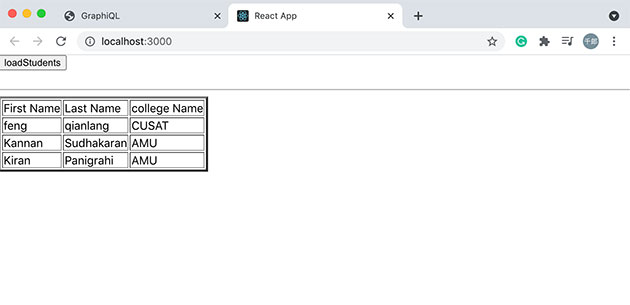GraphQL Apollo 客户端
我们已经使用 Apollo Server 在服务器端构建了 graphql 规范。构建生产就绪的 GraphQL 服务器既快速又容易。现在让我们了解客户端。
Apollo Client 是使用 GraphQL 构建客户端应用程序的最佳方式。该客户端旨在帮助开发人员快速构建一个 UI,该 UI 使用 GraphQL 获取数据并可与任何 JavaScript 前端一起使用。
Apollo Client 支持以下平台
| 序号 | 平台 | 框架 |
|---|---|---|
| 1 | Javascript | React、Angular、Vue、Meteor、Ember |
| 2 | 网络组件 | Polymer, lit-apollo |
| 3 | Native Mobile | 带有 Java 的原生 Android,带有 Swift 的原生 iOS |
缓存是 Apollo Client 的主要功能之一。apollo-boost 是一个方便的扩展包,它带来了许多其他依赖项。
让我们看看如何使用 Apollo Client 构建客户端应用程序
设置服务器
要设置服务器,请按照以下步骤操作
一、 下载并安装项目所需的依赖项
创建一个名为apollo-server-app的文件夹。从终端将目录更改为 apollo-server-app。然后,按照开发环境的搭建中说明的步骤 3 到 5 完成下载和安装过程。
二、 创建schema
在项目文件夹 apollo-server-app 中添加 schema.graphql 文件并添加以下代码
schema.graphqltype Query { students:[Student] } type Student { id:ID! firstName:String lastName:String college:College } type College { id:ID! name:String location:String rating:Float }
三、创建解析器
在项目文件夹中创建一个文件resolvers.js,并添加以下代码
resolvers.jsconst db = require('./db') const Query = { // students 解析器函数返回一个列表 students:() => db.students.list(), } const Student = { college:(root) => { return db.colleges.get(root.collegeId); } } module.exports = {Query,Student}
四、运行应用程序
创建 server.js 文件并参考开发环境的搭建章节中的步骤 8。下一步是在终端中执行命令 npm start。服务器将在 9000 端口上启动并运行。在这里,我们使用 GraphiQL 作为客户端来测试应用程序。打开浏览器并输入 URL,http://localhost:9000/graphiql。
在编辑器中输入以下查询
{
students{
id
firstName
college{
name
}
}
}
来自服务器的响应如下
{
"data": {
"students": [
{
"id": "S1001",
"firstName": "feng",
"college": {
"name": "CUSAT"
}
},
{
"id": "S1002",
"firstName": "Kannan",
"college": {
"name": "AMU"
}
},
{
"id": "S1003",
"firstName": "Kiran",
"college": {
"name": "AMU"
}
}
]
}
}
设置客户端
为客户端打开一个新终端。在执行客户端应用程序之前,服务器终端应该保持运行。React 应用程序将在端口号 3000 上运行,服务器应用程序将在端口号 9000 上运行。
一、创建一个 React 项目 hello-world-client
在客户端,输入以下命令
$ npx create-react-app hello-world-client
这将安装典型 React 应用程序所需的一切。 npx 实用程序和 create-react-app 工具创建一个名为 hello-world-client 的项目。 安装完成后,在 VSCode 中打开项目。
二、启动 hello-world-client
将终端中的当前文件夹路径更改为 hello-world-client。输入 npm start 启动项目。这将在端口 3000 运行开发服务器,并将自动打开浏览器并加载 index 页面。

三、安装 Apollo 客户端库
要安装 Apollo 客户端,打开一个新终端并位于当前项目文件夹路径中。输入以下命令
$ npm install apollo-boost graphql
这将下载客户端的 graphql 库以及 Apollo Boost 包。我们可以通过在 apollo-boost 依赖项中输入 npm view 来交叉检查。这将有许多依赖项,如下所示
apollo-cache-inmemory: ^1.6.6 apollo-link: ^1.0.6
apollo-cache: ^1.3.5 graphql-tag: ^2.4.2
apollo-client: ^2.6.10 ts-invariant: ^0.4.0
apollo-link-error: ^1.0.3 tslib: ^1.10.0
apollo-link-http: ^1.3.1
我们可以清楚地看到安装了 Apollo-Client 库。
四、修改 index.js 文件中的 App 组件
使用 Apollo Client,我们可以直接调用服务器,无需使用 fetch API。此外,查询和更改不应嵌入使用反引号表示法的字符串中。这是因为gql函数直接解析查询。这意味着,程序员可以像在 GraphiQL 工具中编写查询一样直接编写查询。 gql 是一个标签函数,它将解析以反引号表示法编写的模板字符串到 graphql 查询对象。Apollo Client 查询方法返回一个承诺 promise。
以下代码片段显示了如何导入 Apollo Client
import {ApolloClient, HttpLink, InMemoryCache} from 'apollo-boost'
const endPointUrl = 'http://localhost:9000/graphql'
const client = new ApolloClient({
link: new HttpLink({uri:endPointUrl}),
cache:new InMemoryCache()
});
在上一章中,我们讨论了如何对 HTTP 请求使用 fetch API。下面的代码展示了如何使用 gql 函数。loadStudentsAsync 函数使用graphql客户端查询服务器。
async function loadStudentsAsync() {
const query = gql`
{
students{
id
firstName
lastName
college{
name
}
}
}`
const {data} = await client.query({query}) ;
return data.students;
}
只需要将index.js保存在src文件夹中,将 index.html 保存在 public 文件夹中;可以删除自动生成的所有其他文件。
目录结构如下
hello-world-client /
-->node_modules
-->public
index.html
-->src
index.js
-->package.json
以下是 React 应用程序中的 index.js
import React, {Component} from 'react';
import ReactDOM from 'react-dom';
// apollo 客户端
import {ApolloClient, HttpLink, InMemoryCache} from 'apollo-boost'
import gql from 'graphql-tag'
const endPointUrl = 'http://localhost:9000/graphql'
const client = new ApolloClient({
link: new HttpLink({uri:endPointUrl}),
cache:new InMemoryCache()
});
async function loadStudentsAsync() {
const query = gql`
{
students{
id
firstName
lastName
college{
name
}
}
}
`
const {data} = await client.query({query}) ;
return data.students;
}
class App extends Component {
constructor(props) {
super(props);
this.state = {
students:[]
}
this.studentTemplate = [];
}
async loadStudents() {
const studentData = await loadStudentsAsync();
this.setState({
students: studentData
})
console.log("loadStudents")
}
render() {
return(
<div>
<input type = "button" value = "loadStudents" onClick = {this.loadStudents.bind(this)}/>
<div>
<br/>
<hr/>
<table border = "3">
<thead>
<tr>
<td>First Name</td>
<td>Last Name</td>
<td>college Name</td>
</tr>
</thead>
<tbody>
{
this.state.students.map(s => {
return (
<tr key = {s.id}>
<td>
{s.firstName}
</td>
<td>
{s.lastName}
</td>
<td>
{s.college.name}
</td>
</tr>
)
})
}
</tbody>
</table>
</div>
</div>
)
}
}
ReactDOM.render(<App/>, document.getElementById('root'));
一旦我们点击 loadStudents 按钮,react 应用程序将从 GraphQL 服务器加载学生信息,如下所示

